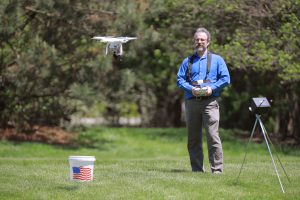Drones monitoring algal blooms capture high-quality, low-cost data to protect drinking water, swimmer safety
July 18th, 2019 by Tyrel LinkhornLow-flying eyes in the sky are improving the accuracy of water quality assessments in the Great Lakes and the rivers that flow into them.
A new study at The University of Toledo finds drones armed with sensors are useful tools in the fight against harmful algal blooms, particularly for monitoring key spots within Lake Erie, such as near drinking water inlets and off the shore of public beaches.
Researchers compared data gathered by the drones with satellite data and boat-based water sampling at 10 locations over Lake Erie and the Maumee River.
“We get the same results on both drones compared to more expensive and time-consuming measurements – including some made by probes put directly into the water,” said Dr. Richard Becker, associate professor in the UToledo Department of Environmental Sciences.
The technology places a new weapon in the arsenal of water treatment plant managers protecting the drinking water supply and public health officials monitoring beaches.
Filling the short-range surveillance gap left by more expensive remote-sensing methods such as satellites and aircraft, the unmanned aerial systems offer increased algae awareness due to their ability to hover below cloud cover and to be deployed on short notice.

Dr. Richard Becker used a drone to assess water quality on Lake Erie.
“Detecting the threat of toxic algae as early as possible is critical, but it can be foggy for satellites looking through different layers of the atmosphere,” Becker said. “These drones are focused and have the ability to assess the condition at the shoreline, which people care about for swimming.”
Determined to safeguard the community’s health, Becker built and tested an algae monitoring drone in the summer of 2017, costing roughly $2,000. The drone took off from either the UToledo research vessel or the shoreline and flew at an altitude of between 5 and 10 meters above the water’s surface.
“Since drones are inexpensive, quick to launch, and can fly under cloudy skies, they have a lot of advantages that make up for the practical limitations of satellite, aircraft or boat-based observations,” Dr. Thomas Bridgeman, director of the UToledo Lake Erie Center and professor of ecology, said.
The study published in the Journal of Great Lakes Research shows Becker’s team in collaboration with Michigan Tech Research Institute successfully demonstrated the utility of drones outfitted with hyperspectral spectroradiometers to measure water-quality parameters that include chlorophyll, suspended minerals, cyanobacteria index and surface scums.
The sensor is used to produce a cyanobacterial index, which is a measure of algal bloom intensity.
“Dr. Becker and his colleagues show that sophisticated optical measurements of harmful algal blooms collected by drone-based sensors are just as good as similar measurements made from a boat,” Bridgeman said.
Bridgeman’s research team aboard the UToledo Lake Erie Center’s research vessel collects water samples and tracks harmful algal blooms once a week every summer throughout algal bloom season to help sound the early warning for water treatment plant operators.
“This new research means that harmful algal blooms impacting a swimming beach, a reservoir used for drinking water, or the Maumee River could be scanned by someone standing on the shoreline piloting a drone,” Bridgeman said.
Making measurements with a higher spatial resolution, the drones bridge a gap and complement the measurements of satellites, said Becker, but they’re not the stand-alone solution.
“A drone is not always the right tool for the job. A satellite or airplane is a better choice when talking about wide swaths of Lake Erie, instead of a targeted area,” Becker said.
The research was supported by NASA’s Glenn Research Center and the National Science Foundation.
Tyrel Linkhorn is
Tyrel Linkhorn is UT's Media Relations Specialist. Contact him at 419.530.5549 or tyrel.linkhorn@utoledo.edu.
Email this author | All posts by
Tyrel Linkhorn

